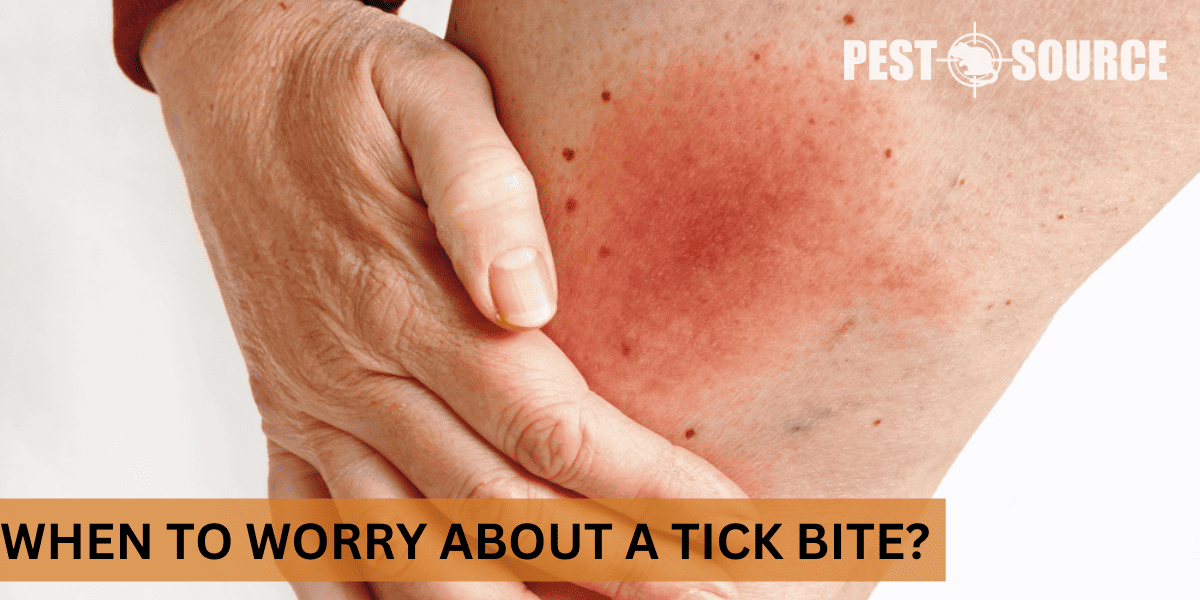When it comes to pesky outdoor pests, ticks top the list. Being bitten by one can lead to more than just an itchy spot; it can result in a range of serious infections, including Lyme disease and Rocky Mountain spotted fever. So, when should you start worrying about a tick bite?
This comprehensive guide delves into the characteristics of ticks, how to identify a tick bite, common symptoms and side effects, the progression and sensations of a tick bite, and more importantly, when you should be concerned and seek medical help. Being prepared and armed with the right information can go a long way in managing and potentially preventing the health risks associated with tick bites.
POINTS
- Ticks are small, blood-sucking arachnids that feed on humans and animals. They have the potential to transmit various diseases, such as Lyme disease and Rocky Mountain spotted fever. A tick bite usually starts as a tiny, red bump and may develop into a larger rash, sometimes with a distinctive bull’s-eye pattern.
- Not all tick bites are harmful, but it’s essential to monitor for any changes or developments, especially the occurrence of a rash or flu-like symptoms such as fatigue, fever, or headache.
- An infected tick bite may become red, swollen, and has the potential to ooze pus. If you notice these signs along with systemic symptoms like a high fever, seek medical help immediately.
- If you cannot completely remove the tick, if the bite site becomes infected, or if flu-like symptoms emerge, that’s when you should seek medical attention.
- Prevention and early detection are critical when it comes to tick bites. Wear appropriate clothing, use tick repellents when in tick-prone areas, and check your body thoroughly after being outdoors. If any unusual symptoms occur after a tick bite, seek immediate medical attention.
What Are Ticks and Their Characteristics?
What is a tick?
A tick is a tiny, blood-sucking arachnid that feeds on the blood of mammals, birds, reptiles, and amphibians. There are over 800 species of ticks worldwide, but only a few types are commonly found on humans or pets.
Below is a table that outlines different types of ticks, highlighting their key features, preferred hosts, and primary regions where they are found, which can help in their identification and understanding of their potential threat.
| Type of Tick | Image | Size (before feeding) | Preferred Hosts | Primary Regions Found |
|---|---|---|---|---|
| Deer Tick (Ixodes scapularis) |  | 3-5 mm | Deer, rodents, humans | Eastern and northern Midwest USA |
| Dog Tick (Dermacentor variabilis) |  | 5-15 mm | Dogs, rodents, humans | Throughout USA |
| Lone Star Tick (Amblyomma americanum) |  | 3-10 mm | Livestock, deer, humans | Southeastern and eastern USA |
| Brown Dog Tick (Rhipicephalus sanguineus) | 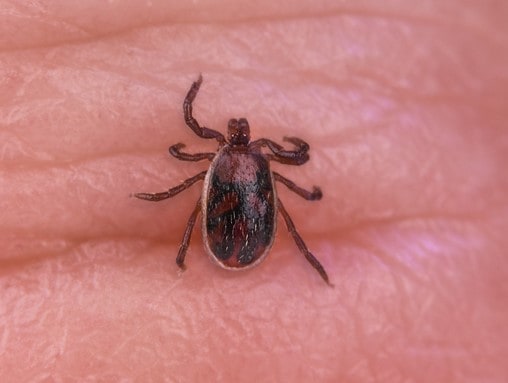 | 2-3 mm | Dogs | Worldwide, common in USA |
| Western Black-legged Tick (Ixodes pacificus) |  | 3-5 mm | Deer, rodents, humans | Western USA |
What does a tick look like?
Ticks have a flat and oval body shape before they feed. Upon feeding, they swell and become round. Their color ranges from shades of brown to reddish-brown and black. An adult tick has eight legs.
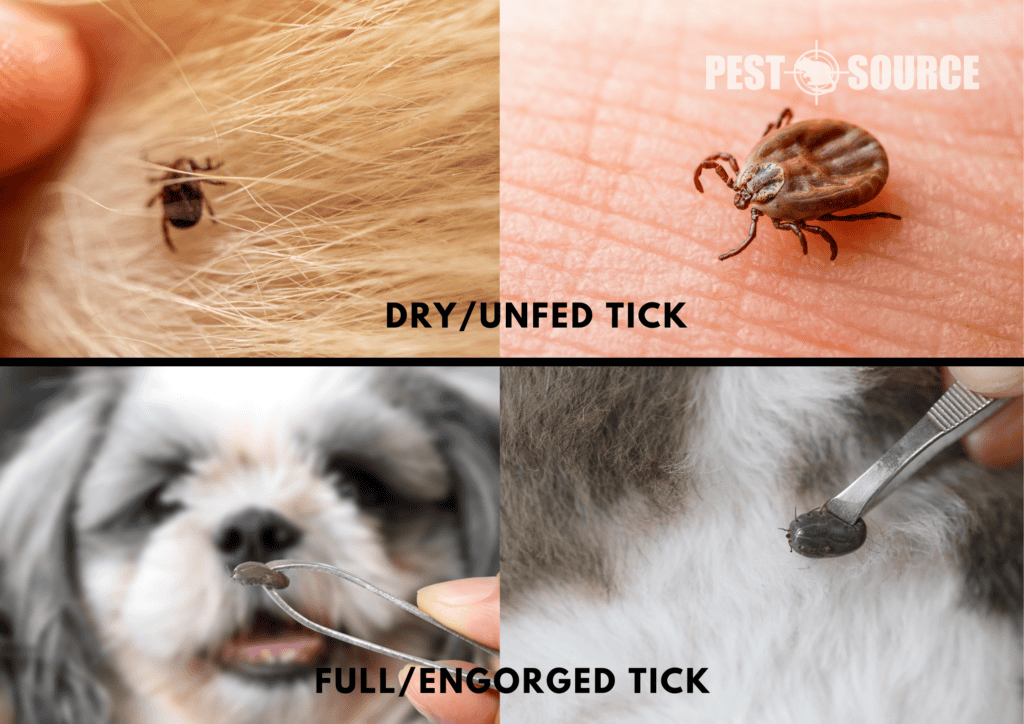
Do ticks bite humans and why?
Yes, ticks can be dangerous as they bite humans because they need a blood meal to grow and reproduce. Human blood is an excellent food source for ticks.

What does a tick feel like?
When a tick latches onto your skin, you might not feel anything at first. However, as it starts to bite and feed, it may cause irritation and a tickle-like sensation, similar to a mosquito bite.
What do ticks do to humans?
Ticks are not just nuisances; they are vectors for various diseases that can significantly impact human health. Here’s a breakdown of the primary actions ticks take when interacting with humans and the potential health risks involved:
- Blood Feeding: Ticks attach to their human hosts to feed on blood, which is necessary for their growth and reproduction.
- Disease Transmission: During feeding, ticks can transmit pathogens that cause diseases such as Lyme disease, Rocky Mountain spotted fever, and Tularemia.
- Immune Response: The bite of a tick can trigger an immune response in humans, resulting in symptoms like redness, swelling, and itching at the bite site.
- Anesthetic Chemicals: Ticks secrete substances that numb the skin, allowing them to feed unnoticed for extended periods.
- Saliva Transmission: Along with blood feeding, ticks inject saliva that can carry diseases, complicating the immune response and increasing the risk of disease transmission.
- Long-term Attachment: Ticks can remain attached to their host for several days to complete their feeding, increasing the risk of disease the longer they stay attached.
Understanding these interactions is crucial for recognizing the risks associated with tick bites and for taking appropriate preventive measures.
How to Identify a Tick Bite?
Identifying a tick bite correctly is essential for timely and appropriate treatment, as tick bites can sometimes resemble other insect bites. Below is a table that compares tick bites to other common insect bites, providing key identifiers and typical reactions to help distinguish between them.
| Bite Type | Appearance | Typical Reaction Time | Itchiness | Key Identifiers |
|---|---|---|---|---|
| Tick Bite | Small red dot, may swell | Slow to develop | Varies | May develop into larger rash, sometimes bull’s-eye pattern |
| Mosquito Bite | Puffy and reddish | Immediate | Yes | Very itchy, rapid onset |
| Flea Bite | Small red bumps | Immediate | Yes | Often around ankles or legs, extremely itchy |
| Spider Bite | Red skin, possibly severe | Immediate to slow | Varies | Sharp pain at bite site, severe cases with necrosis |
| Bee Sting | Red, swollen welt | Immediate | Mild | Sharp pain, welt with a central puncture point |
What does a tick bite look like?

A tick bite looks similar to other insect bites so it can be hard to identify. It usually begins as a small red dot and could slightly swell. It doesn’t necessarily itch at the beginning, but over time, itchiness and irritation can develop.
What does a tick bite look like on a dog?
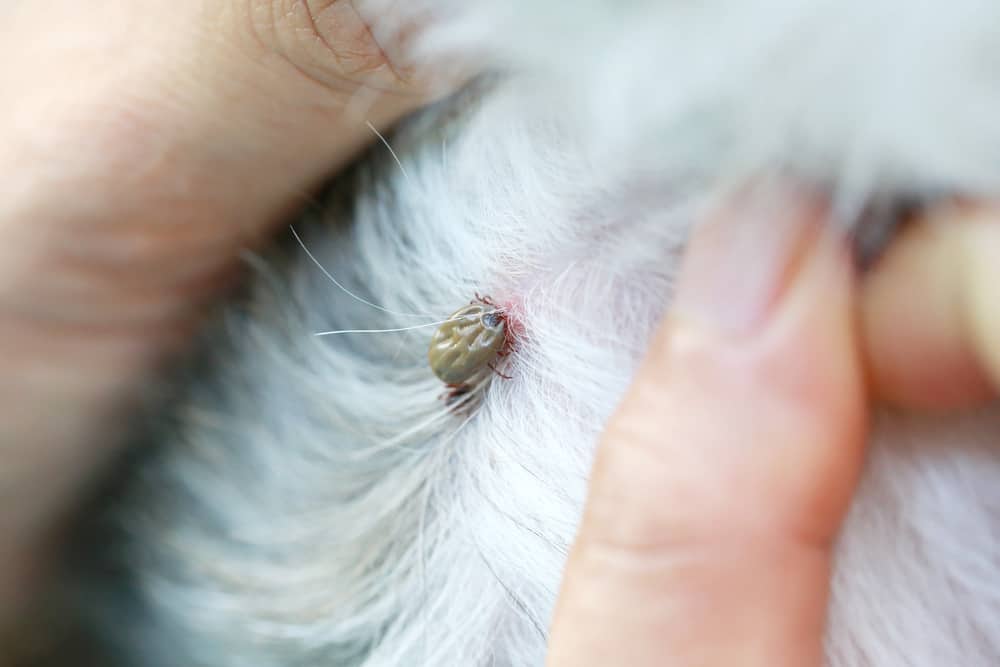
On dogs, tick bites can be quite hard to spot because of their fur. When you conduct physical checks, you might come across tiny, bump-like structures attached to the dog’s skin – that’s likely a tick. The area around the tick bite may become red and inflamed.
What does a deer tick bite look like?

A deer tick bite often presents as a small red bump, similar to a mosquito bite. As it progresses, it might develop into a distinctive “bull’s-eye” pattern—a circular red rash that spreads outward with a clear center.
What do tick bites look like on humans?
Just like on dogs, tick bites on humans start as tiny red bumps. Over time, it may develop into a larger rash, sometimes with a bull’s-eye pattern. Other signs of a tick bite could include swelling, blistering, or the site becoming painful or warm to touch.
What does a tick look like in skin?

If the tick remains attached, it can be identified as a small, dark bit embedded in the skin. They’re most often found in warm, hard-to-see places like hairline, underarms, or groins. The attached tick will grow larger and darker as it feeds.
What are the Symptoms and Side Effects of a Tick Bite?
What are the symptoms of a tick bite?
Tick bites often do not cause immediate noticeable symptoms. The following table lists common symptoms associated with tick bites, including the associated diseases and the typical timeframe for symptom onset, helping to better understand the implications of a tick encounter.
| Symptom | Associated Diseases | Onset Time After Bite | Description |
|---|---|---|---|
| Small red bump | General reaction, no specific disease | Immediate to 48 hours | Initial bite reaction, usually harmless |
| Bull’s-eye rash | Lyme disease | 3 to 30 days | Expanding red area with a central clearing |
| Fever | Many tick-borne diseases (e.g., Ehrlichiosis) | 1 to 2 weeks | Often accompanied by other flu-like symptoms |
| Headache | Lyme disease, Rocky Mountain spotted fever | 1 to 3 weeks | Can be mild to severe |
| Fatigue | Lyme disease, Anaplasmosis | 1 to 2 weeks | Commonly severe, similar to flu fatigue |
| Muscle and Joint Pain | Lyme disease, Colorado tick fever | 1 to 3 weeks | Often severe and debilitating |
| Nausea | Tick-borne relapsing fever | 1 week | Can accompany fever and headache |
| Swollen lymph nodes | Tularemia, Lyme disease | 1 to 3 weeks | Indicator of immune response to infection |
What are the tick fever symptoms?

In case of tick-borne diseases like tick fever, symptoms can range from mild to severe, including fever, headache, muscle and joint pain, and possibly a rash. These symptoms typically start to appear within the first week after the tick bite.
What are tick bite side effects?

Apart from the immediate rash and itchiness, side effects of a tick bite can include signs of infections like Lyme disease or Rocky Mountain spotted fever. These signs can include fever, tiredness, nausea, or muscle pain.
How soon after a tick bite do symptoms appear?
The onset of symptoms varies, depending largely on the type of tick and the disease it might carry. Symptoms can start appearing as early as 3 days up until 30 days after the tick bite.
How long after a tick bite do symptoms appear?
As mentioned, symptoms can emerge anywhere from three days to a month after a tick bite. However, this could vary depending on numerous factors such as the individual’s immune system and the type of tick-borne disease. If you experience any symptoms following a tick bite, it’s essential to seek prompt medical attention.
How Does a Tick Bite Progress?
Identifying a tick embedded in the skin is critical for preventing diseases that ticks transmit through prolonged feeding. The table below illustrates the progression of a tick’s appearance in the skin over time, helping individuals recognize and promptly address tick bites.
| Day of Attachment | Appearance Description | Size Change | Additional Notes |
|---|---|---|---|
| Day 1 | Small, dark spot embedded in the skin | None | Tick may go unnoticed |
| Day 2-3 | Tick enlarges slightly, becomes more noticeable | Slight enlargement | Becomes more visible as it fills with blood |
| Day 4-5 | Tick body significantly engorged | Considerable enlargement | Clearly visible, engorged with host’s blood |
| After 1 Week | Fully engorged tick, much larger than initial size | Maximum size reached | Tick may start to detach after full engorgement |
What are the stages of a tick bite?
Several stages follow a tick bite.
- At first, there’s the initial bite, which may go unnoticed.
- Within a day or two, a small red bump may appear.
- Over the next few days, the area may become itchy and irritated.
- In some cases, a large circle rash or a “bull’s-eye” rash may develop around the tick bite.
How does a tick bite look after a week?
A week after a tick bite, the redness should start to recede. However, if the tick transmitted bacteria causing diseases like Lyme disease, a distinctive “bull’s-eye” rash could form. This rash may start appearing 3 to 30 days after the bite itself.
What does a normal tick bite rash look like?

A typical tick bite rash can look like a red spot or bump. If the tick carried bacteria and has caused an infection, this red spot can expand to create a larger, circular rash, sometimes resembling a “bull’s-eye”.
What does a tick bite look like on day 1?
On day 1, a tick bite may look like a small red bump on your skin. There may also be minor swelling or irritation.
What does a tick bite mark look like?
Even after the tick has been removed, the bite mark may linger—a tiny red or bruised-looking spot, sometimes surrounded by fading redness.
Tick bite bump won’t go away, is this normal?
If the bump at the site of a tick bite won’t go away, it could be a sign of a tick-borne disease. It’s crucial to consult a doctor in such cases, especially if the bump is accompanied by additional symptoms like fever, fatigue, or muscle and joint aches.
What Sensations and Reactions Can One Expect From a Tick Bite?

Does a tick bite hurt?
Typically, tick bites are painless. You might not even realize you’ve been bitten until symptoms start showing. Ticks secrete anesthetic-like substances in their saliva that numb the skin, allowing them to feed without you noticing it.
Why does my tick bite hurt?
Though most tick bites don’t hurt, some may become painful after a few days, especially if they are infected or cause an allergic reaction. If a bite is causing significant discomfort, it’s advisable to seek medical attention.
What does a tick bite feel like?
Most people don’t feel tick bites when they happen. Afterward, the bite area may become itchy, swollen, or red. If the tick is still attached, you may feel a small lump at the bite site.
Are tick bites painful?
Tick bites themselves are usually not painful. However, if the bite causes an allergic reaction or leads to an infection, it can become painful or itchy.
What is a tick bite reaction?
A tick bite reaction can range from no symptoms to severe symptoms. Common reactions include redness, swelling, or a rash at the bite site. More severe reactions can include flu-like symptoms or development of a bull’s-eye rash, signaling a potential tick-borne disease.
Tick bite swollen and painful, is this normal?
While it’s normal for a tick bite to exhibit a bit of redness or swelling, severe pain or lasting swelling could be a sign of infection or a tick-borne illness. In such cases, it’s crucial to see a doctor.
When to Worry About a Tick Bite?
When should one worry about a tick bite?
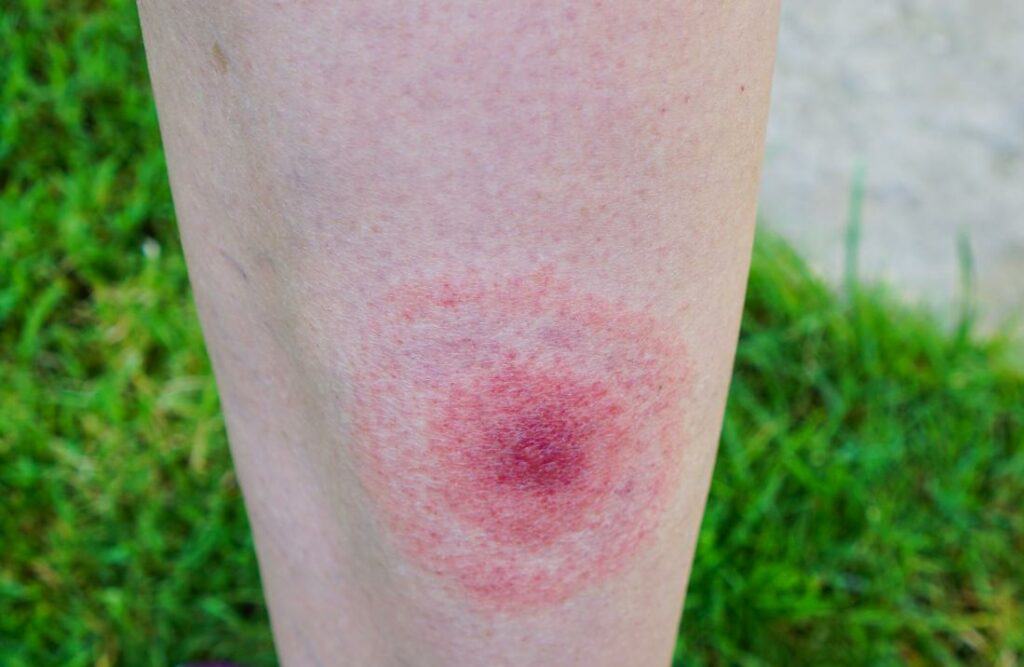
Understanding when to be concerned about a tick bite is crucial for timely medical intervention, especially when tick-borne diseases are a possibility. The table below highlights specific conditions and symptoms associated with tick bites that should prompt immediate concern and potentially a visit to a healthcare provider.
| Condition or Symptom | Description | Level of Concern | Recommended Action |
|---|---|---|---|
| Rash, especially a bull’s-eye pattern | A circular rash that spreads outward with a clear center | High | Seek medical attention immediately |
| Flu-like symptoms | Fever, headaches, fatigue, muscle pains | High | Consult a doctor for possible Lyme disease |
| Severe pain at bite site | Intense pain specifically at the location of the bite | Moderate to High | Seek medical evaluation |
| Difficulty breathing | Sign of a possible severe allergic reaction | Very High | Emergency medical care needed |
| Persistent symptoms | Symptoms lasting more than a week without improvement | High | Medical follow-up advised |
| Tick part remains embedded | Part of the tick remains after attempt to remove it | Moderate to High | Seek medical help to remove it safely |
When to be concerned about a tick bite?
Aside from worrying about symptoms post-bite, you should also be concerned if the tick body parts like the head remain in your skin after trying to remove it, or if the tick is not fully removed.
What are the tick bites to worry about?
You need to worry about tick bites that cause a rash, a fever, headache, muscle or joint pain, or feel warm to the touch. This could be a sign of a tick-borne disease and requires immediate medical attention.
What to look for after a tick bite?
After a tick bite, watch for expanding redness or rash around the bite site. Monitor for any signs of illness such as fever, chills, muscle aches, or joint pains.
How to tell if a tick bite is infected?

An infected tick bite may be extremely red, warm, swollen, and might ooze pus. The person may develop systemic symptoms like high fever. If you notice such signs, seek medical help promptly.
What does an infected tick bite look like?
An infected tick bite can look like a red, swollen bump that continues to enlarge. Over time, it may fill with pus or start to form a bull’s-eye appearance. It may be excessively painful or tender to touch.
When to Seek Medical Help for a Tick Bite?

When to see a doctor for a tick bite?
It’s crucial to know when to seek medical help after a tick bite, as prompt treatment can prevent serious complications associated with tick-borne diseases. Here are key scenarios where medical consultation is necessary:
- Tick Remains Embedded: Seek medical help if you are unable to completely remove the tick or if part of the tick (like the head) remains in the skin.
- Signs of Infection: If the bite site becomes red, swollen, or starts oozing, it’s important to see a doctor to prevent or treat an infection.
- Development of a Rash: Any rash, particularly a bull’s-eye rash, should prompt an immediate visit to the doctor as it is a common sign of Lyme disease.
- Flu-like Symptoms: Symptoms such as fever, chills, fatigue, body aches, and headaches that occur after a tick bite may indicate a tick-borne illness.
- Severe Pain or Swelling: Significant discomfort or swelling around the bite site can be signs of a secondary infection or allergic reaction.
- Breathing Difficulties or Severe Allergic Reactions: Immediate emergency care is needed if you experience severe reactions like difficulty breathing, which could indicate a severe allergic response.
Understanding these guidelines can help you take timely action and potentially prevent the progression of serious health issues following a tick bite.
Should I go to the doctor for a tick bite?
Although not all tick bites require a visit to the doctor, you absolutely should seek medical attention if you develop symptoms like a red rash, fever, fatigue, or headache. Specialists can accurately diagnose and treat any potential tick-borne diseases.
When to go to the doctor for a tick bite?
Go to the doctor if the tick hasn’t been completely removed, the rash extends out from the tick bite or if you start to feel unwell several days to a few weeks after a tick bite. The quicker these diseases are caught, the easier they are to treat.
What happens when a tick bite is swollen, like a tick bite on a private part?
A swollen tick bite, especially one in a private or sensitive area, can be concerning. It can be a manifestation of an allergic reaction or an infection. Ensure to seek professional medical assistance to handle such situations.
Conclusion
Knowing how to handle and respond to tick bites is crucial due to the potential health risks they pose. Detecting tick bites early, monitoring them for changes or developments, and understanding when medical intervention is needed can help protect your wellbeing.

